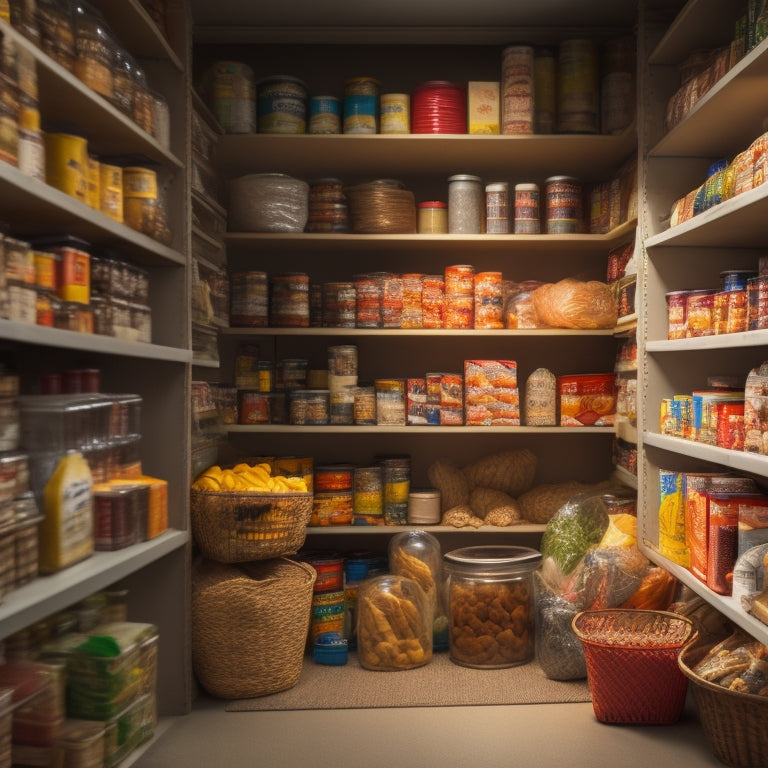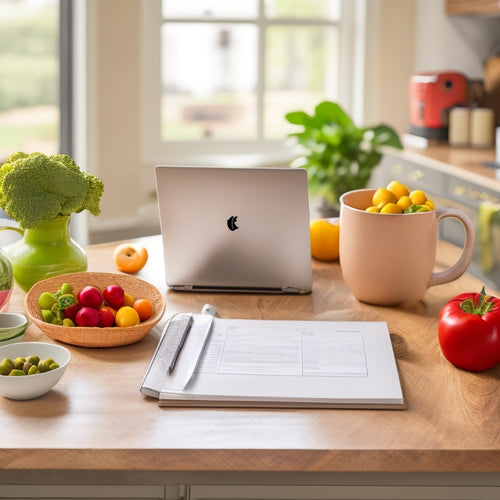
What's Holding You Back From a Clutter-Free Pantry?
Share
You're stuck with a cluttered pantry because common pitfalls, like poor time management, ineffective storage solutions, and inefficient shopping habits, are undermining your best efforts to achieve a organized space. You might be ignoring expiration dates, buying duplicates, or using inadequate storage, leading to clutter and forgotten items. Perhaps you're struggling to maintain organization systems or optimize corner spaces. Whatever the issue, addressing these roadblocks is key to achieving a clutter-free pantry. By identifying and overcoming these challenges, you'll open a space that's efficient, accessible, and stress-free - and you're just one step away from making that a reality.
Key Takeaways
• Poor time management and lack of maintenance habits hinder achieving a clutter-free pantry.
• Inadequate storage space and inefficient use of corner spaces lead to clutter accumulation.
• Unproductive shopping habits, like impulse buying, contribute to a cluttered pantry.
• Failure to address common roadblocks, such as cluttered shelves and forgotten items, prevents a dream pantry.
• Insufficient labeling and visibility of items make it difficult to maintain organization and accessibility.
Pantry Organization Roadblocks
Several common obstacles stand in the way of achieving your dream pantry, and recognizing these roadblocks is the first step to overcoming them.
One major hurdle is poor time management. You're busy, and dedicating hours to pantry organization can seem overwhelming. However, by breaking it down into smaller tasks and scheduling them into your daily routine, you'll be on your way to a clutter-free pantry in no time.
Another obstacle is ineffective decluttering techniques. You might be holding onto items 'just in case' or because you feel guilty about wasting food. It's crucial to develop a ruthless mindset when it comes to getting rid of expired, spoiled, or unnecessary items.
Implementing labeling strategies will also help you maintain your newly organized pantry. By categorizing and labeling your items, you'll be able to find what you need quickly and easily.
Additionally, meal planning can help reduce food waste and prevent clutter from building up in the future. By addressing these common roadblocks, you'll be well on your way to achieving the pantry of your dreams.
Cluttered Shelves and Forgotten Items
Your pantry shelves are likely a jumble of containers, bags, and boxes, with forgotten items hiding in the back or top shelves, making it difficult to find what you need when you need it. This cluttered mess leads to wasted time, money, and food. It's time to take control of your pantry inventory and get organized.
Here are some common culprits of cluttered shelves:
| Item | Reason for Clutter | Solution |
|---|---|---|
| Expired Canned Goods | Ignoring expiration dates | Check expiration dates regularly, donate or discard expired items |
| Duplicate Items | Buying in bulk without a plan | Implement a "first in, first out" system for similar items |
| Unlabeled Containers | Forgetting what's inside | Label containers with contents and date stored |
Inadequate Storage Space Solutions
Maximize your pantry's storage capacity by identifying and utilizing hidden spaces, such as the back of doors, walls, and corners, to create a more functional and organized storage system. By doing so, you'll open up valuable real estate for storing items that are often overlooked or forgotten.
Consider vertical storage solutions, like floor-to-ceiling shelves or stackable baskets, to make the most of your pantry's vertical space. This will allow you to store more items in a smaller footprint, keeping your pantry feeling spacious and clutter-free.
To further optimize your storage, incorporate pull-out drawers and adjustable shelving into your design. These features will enable you to easily access items in the back of your pantry and make adjustments as your storage needs change. By implementing these solutions, you'll be able to store more items in a smaller space, keeping your pantry organized and functional.
With a well-designed storage system, you'll be able to find what you need when you need it, making meal prep and cooking a breeze.
Difficulty Maintaining Organization Systems
After designing a functional storage system, you'll need to develop habits to maintain it, as even the best organizational systems can quickly become cluttered and disorganized if not regularly maintained.
To guarantee your pantry organization stays on track, prioritize organization maintenance by setting aside time each week to tidy up and restock. Allocate a specific day and time for pantry maintenance, and stick to it. This will help you stay focused and avoid procrastination.
Effective time management is essential in maintaining your pantry organization. Set a timer for 15-20 minutes and challenge yourself to declutter and organize as much as possible during that time. This technique will help you stay focused and motivated.
Additionally, implement decluttering tips such as the 'one in, one out' rule, where you remove an old item every time you bring a new one into your pantry. By incorporating these habits into your daily routine, you'll be able to maintain your pantry organization and enjoy the benefits of a clutter-free space.
Lack of Visibility and Accessibility
Two common obstacles to a clutter-free pantry are lack of visibility and accessibility, which can lead to expired or spoiled food going unnoticed and essential items being hard to reach. You may find yourself digging through shelves or containers to find what you need, only to discover it's expired or spoiled. This not only wastes time but also money and resources.
To combat this, you need to create a system that allows you to see what you have and easily access it. Start by using clear containers to store dry goods, canned goods, and other pantry staples. This will enable you to see what's inside without having to rummage through the container.
Additionally, consider installing a Lazy Susan in a corner or on a shelf to make the most of your pantry's real estate. This will allow you to easily spin the turntable to access items that would otherwise be out of reach.
Inefficient Use of Corner Space
When you're designing your pantry layout, you'll often find that corner spaces are the most challenging areas to utilize effectively, leading to wasted space and difficulty accessing items stored in these areas.
It's crucial to optimize these corners to maximize your pantry's potential. One solution is to install corner shelving, which can be customized to fit your specific needs. This can include rotating carousels, pull-out baskets, or adjustable shelves.
By implementing space-saving solutions, you can efficiently store items like canned goods, cookbooks, or infrequently used kitchen gadgets. This won't only free up valuable space but also make it easier to find what you need when you need it.
Consider using a Lazy Susan or a turntable to make the most of hard-to-reach areas. By addressing the inefficient use of corner space, you'll be one step closer to achieving a clutter-free pantry that functions seamlessly.
Unproductive Shopping Habits
You're likely guilty of unproductive shopping habits that contribute to pantry clutter, such as buying in bulk without a plan or failing to check what you already have on hand before heading to the store.
These habits lead to impulse purchases, which often result in items that go unused or expire before you can consume them. Furthermore, overspending habits can lead to a pantry overflowing with unnecessary items, making it difficult to maintain organization.
To break free from these habits, start by creating a shopping list and sticking to it. Before you go to the store, take stock of what you already have at home to avoid duplicating purchases.
Consider meal planning to make sure you're buying only what you need for the week. Additionally, set a budget and track your spending to avoid overspending.
Frequently Asked Questions
How Do I Decide What Pantry Items to Keep and What to Discard?
When deciding what pantry items to keep and discard, you'll start a pantry purge by identifying essential pantry items, then apply declutter tips like the "first in, first out" rule and "use-by" date checks to make swift decisions.
Can I Organize My Pantry With Items I Already Have at Home?
You can create a clutter-free pantry without breaking the bank by repurposing containers, utilizing shelves and baskets, and implementing DIY solutions that maximize storage and accessibility, all with items you already have at home.
Are There Any Pantry Organization Systems Suitable for Small Budgets?
You're on a mission to tame your pantry chaos without breaking the bank! Luckily, DIY solutions, Dollar store finds, and creative hacks offer thrifty options to get you started on a clutter-free journey.
How Often Should I Clean and Maintain My Pantry Organization System?
You should clean and maintain your pantry organization system every 1-2 months, wiping down shelves and dusting containers, to prevent clutter buildup and guarantee your organizing strategies stay effective.
Can I Organize My Pantry if I Have Limited Mobility or Disabilities?
"In medieval times, knights adapted to battles; now, you can adapt to pantry organization with limited mobility! Utilize adaptive tools, solutions, and consider professional assistance for modifications to create a system that empowers you."
Related Posts
-

Free Low-Carb Meal Planning Templates for Easy Success
You're about to discover the secret to effortless low-carb meal planning: leveraging free, customizable templates tha...
